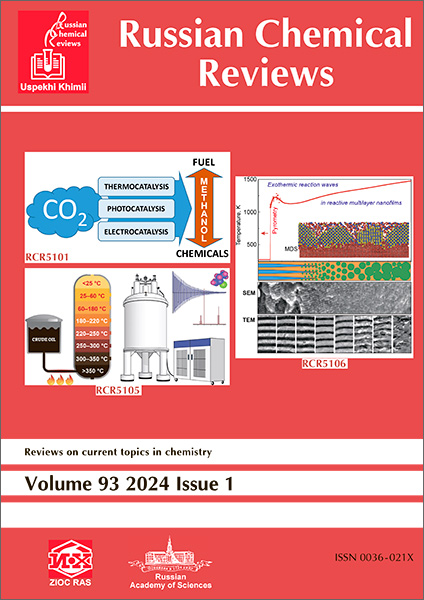从自由基化学到分子自旋装置
IF 6
2区 化学
Q1 CHEMISTRY, MULTIDISCIPLINARY
引用次数: 1
摘要
重新思考自由基在化学、生物学、医学和材料科学中的应用所提供的可能性。这个问题的关键是稳定的有机自由基的化学发展,这为各种功能用途的化合物铺平了道路:自由基试剂、可控自由基聚合的引发剂、高效氧化还原催化剂、自旋标签、高灵敏度分析手段、医学诊断和治疗、磁性和氧化还原活性系统的构建块、有机电子、自旋电子学和电池的关键组件。研究稳定和短寿命顺磁性化合物,特别是高自旋体系的方法的发展,促进了有机自由基应用潜力的急剧增加。这些方法首先包括脉冲EPR技术、SQUID磁强计、x射线衍射(包括使用同步加速器辐射源的方案)、扫描电子显微镜和力显微镜以及极化中子衍射的磁结构分析。计算方法取得了巨大的进步,形成了对磁活动体系的磁性进行建模和预测的有效工具。俄罗斯科学家的研究对有机自由基的化学和物理学的发展及其应用潜力作出了重大贡献。传统上,俄罗斯的研究人员积极参与和组织有关有机自由基化学、分子基磁体、分子自旋装置和电子顺磁共振的会议。本期《俄罗斯化学评论》讨论了与氮原子上含有不饱和基团的氮氧化物自由基有关的大量研究,包括它们的物理化学性质、计算预测和实际应用领域。在这些应用中,值得注意的是分子磁体的设计、氧化还原和光切换分子体系的开发、有机和混合电池的氧化还原活性成分以及在有机合成的选择性氧化过程中作为催化剂和试剂的使用。基于稳定有机自由基和特殊混合系统的量子比特和量子位设计的新研究趋势值得特别关注,以解决量子计算中的缩放和稳定性问题。在所有这些应用领域中,在相当广泛的范围内改变稳定自旋载流子结构的可能性总是会产生新的想法和意图。我们表示希望本期《俄罗斯化学评论》将有助于实现这一目标。本文章由计算机程序翻译,如有差异,请以英文原文为准。
From the chemistry of radicals to molecular spin devices
rethinking the possibilities provided by the use of free radicals in chemistry, biology, medicine and materials science. The key to this issue is development of the chemistry of stable organic radicals, which paved the path towards compounds for various functional purposes: radical reagents, initiators for controlled radical polymerization, efficient redox catalysts, spin labels, highly sensitive means for analysis, medical diagnostics and theranostics, building blocks for magnetic and redox-active systems, and key components of organic electronics, spintronics and electric batteries. The sharp increase in the applied potential of organic radicals was boosted by the development of methods for studying both stable and short-lived paramagnetic compounds, in particular high-spin systems. These methods include, first of all, pulsed EPR techniques, SQUID magnetometry, X-ray diffraction, including protocols using synchrotron radiation sources, scanning electron and force microscopy, and magneto-structural analysis by polarized neutron diffraction. A huge step forward was made by calculation methods, which have formed an efficient tool for modelling and prediction of the magnetic properties of magnetically active systems. The studies of Russian scientists are making a considerable contribution to the development of chemistry and physics of organic radicals and their applied potential. Russian researchers are traditionally active participants and organizers of conferences devoted to the chemistry of organic radicals, molecule-based magnets, molecular spin devices, and electron paramagnetic resonance. This issue of Russian Chemical Reviews addresses a large area of research related to nitroxide radicals containing an unsaturated moiety at the nitrogen atom, including their physicochemical properties, their computational prediction and fields of their practical application. Among the applications, noteworthy is the design of molecular magnets, development of redoxand photoswitchable molecular systems, redox-active components for organic and hybrid batteries and the use as catalysts and reagents in selective oxidative processes of organic synthesis. Special attention is deserved by a new trend of research related to the design of qubits and qudits based on stable organic radicals and special hybrid systems to solve the problem of scaling and stability in quantum calculations. In all these applied fields, the possibility of varying the structure of stable spin carriers over fairly broad limits will always give rise to new ideas and intentions. We express hope that this issue of Russian Chemical Reviews will contribute to this goal.
求助全文
通过发布文献求助,成功后即可免费获取论文全文。
去求助
来源期刊

Russian Chemical Reviews
化学-化学综合
CiteScore
13.00
自引率
5.20%
发文量
27
审稿时长
6-12 weeks
期刊介绍:
Russian Chemical Reviews serves as a complete translation of the esteemed monthly review journal Uspekhi Khimii, which has been a prominent figure in Russian scientific journals since its establishment in 1932. It offers comprehensive access to the advancements made by chemists from Russia and other former Soviet Union countries.
Established in 1932, Russian Chemical Reviews is committed to publishing timely and significant review articles encompassing various facets of modern chemistry, including chemical physics, physical chemistry, computational and theoretical chemistry, catalysis, coordination chemistry, analytical chemistry, organic, organometallic, and organoelement chemistry, chemistry of macromolecules, applied chemistry, biochemistry, bio-organic chemistry, biomolecular chemistry, medicinal chemistry, materials chemistry, nanochemistry, nanostructures, and environmental chemistry.
 求助内容:
求助内容: 应助结果提醒方式:
应助结果提醒方式:


